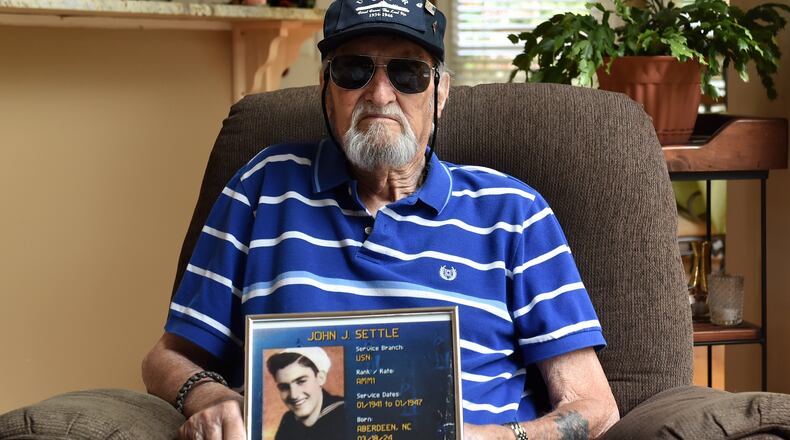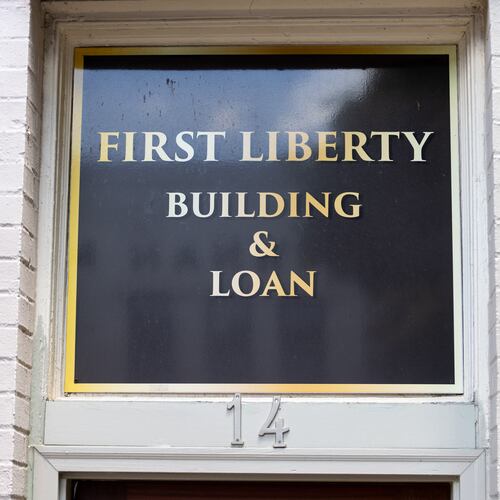JEFF SETTLE
Age: 91
Residence: Marietta
Service: U.S. Navy, plane captain
Jeff Settle has daily reminders about the day in January 1945 when shrapnel from a Japanese anti-personnel bomb hit him in the face, arm and back. He was a Navy plane captain, or crew chief, at Clark Field in the Philippines during World War II when the enemy decided to target a group of 12 U.S. bombers on the ground.
When the attack began, Settle tried to get to a bomb shelter. But since it was too crowded, he crawled under a truck and hoped for the best.
“It blew me out from under the truck. And they said a young lieutenant ran out of the bomb shelter and dragged me back. They said I was picked up by somebody in a jeep and taken to medical.”
The blast had blown off part of the right side of the young sailor’s face, so doctors grafted skin onto Settle from that of a man killed in the raid. They also removed the shrapnel from his arm but couldn’t remove it from his back because it was too close to his spine.
He was taken to an old Catholic church for treatment, and when he woke up, Settle saw a large Japanese man standing in front of him.
“I think I was more frightened than I had been the whole war. I opened my eyes and there was this huge Japanese guy with a stretcher. My first thought was, I’m a prisoner. But he was a prisoner working under guard.”
Settle recovered from his wounds after a few days at the American makeshift hospital. On Jan. 3, he was awarded the Purple Heart by Adm. William Halsey Jr.
“At the time, it really didn’t dawn on me what it meant.”
By that point, Settle had been in the Navy almost four years after signing up at age 16 thanks to the help of his sister-in-law and an altered birth certificate. In fact, in all of his paperwork to this day, the Navy lists Settle as two years older than he actually is.
“It was the greatest thing that ever happened to me. Nobody ever found out. I had a great career in the Navy and I never told a soul.”
The youngest of 11 children in a sharecropping family in North Carolina, Settle left school in the seventh grade to work. But despite those humble beginnings, he dreamed big.
“I was really gung-ho for aviation. … I fell in love and had a craving for airplanes. That was one of my dreams. … There’s nothing I could have done that would have been more pleasurable in my career.”
So upon joining the Navy in 1941, Settle took a test to become a seaman first class and was attached to the USS Ranger as an aviation machinist. By late that year, he was designated a plane captain.
Then, after a brief bout with the mumps and being moved to the USS Yorktown, Settle was somewhere in the North Atlantic when he heard the Japanese had bombed Pearl Harbor.
He spent the next two-plus years training new recruits in Florida and working at a B-24 school in Kansas, then was sent to California to begin training for an island invasion in the South Pacific. The destination? He wasn’t sure at the time, but it ended up being the Philippines.
He remembers the night he woke up, while sleeping in a hammock on the ship’s deck, and was astonished at what he saw.
“I looked out and 360 degrees, as far as you could see, were all kinds of ships. You name it. Everything imaginable for an invasion.”
While recalling the constant raids by Japanese Zero fighters and the kamikaze attacks, Settle told a story about the night he was playing poker in a group of six. After he ran out of money, he left the tent and went to alert the perimeter guards that he was heading to bed. In the blink of an eye, an enemy soldier attacked the tent and killed all of the Americans.
Settle said he saw his share of horrors: burned corpses, dead bodies floating in the bay, soldiers with burning flesh, his friends cut in two by bullets.
“I saw some guys pray, and I did a little of that myself. … Sometimes I would wonder why we’re doing this. I still questioned it after the war was over.”
He also witnessed the callousness of war, like when a U.S. soldier used a Japanese soldier’s skull as an ashtray.
“Things like that woke me up. I never understood the atrocities. I couldn’t come to grips with it. I used to think about that a lot. (The Japanese) just went to war because they had to, just like us.”
Not everything during his stint in the Philippines was negative. Settle finally earned his high school diploma while on the island.
When the war ended in Europe in May 1945, Settle said there was no celebration in the Pacific. There was still work to be done.
But when the Japanese surrendered in September, Settle said it was more a sigh of relief.
“It was like you couldn’t breathe, and then all of a sudden you could. It was a very happy feeling.”
After the war: It's no surprise Settle remained in aviation. After a four-year stint with Delta Air Lines, he worked for Lockheed for 34 years in California, Georgia and in Jordan, finally retiring in 1987. He also earned his private pilot's license and bought his own airplane.
About the Author
Keep Reading
The Latest
Featured



